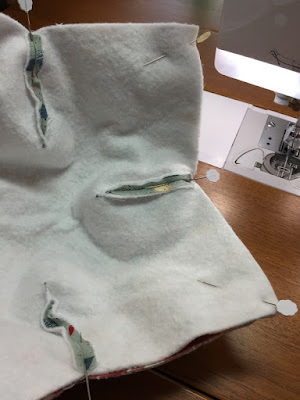Whether brightly contrasting or sublimely subtle, piping can be that little extra element that takes a simple dress, pillow, or bag from "nice" to "wow". It adds a finished, tailored element to the simplest designs. Adding a bit of piping isn't complicated, but it can appear intimidating for inexperienced makers. Once you've gone through the process, you'll be surprised at how truly easy it can be.
I'm going to talk a bit about piping in general, explain how to make your own, and then show how to place any piping into the seams of your project.
You can to buy ready made piping by the yard in most fabric stores. It's often seen in huge displays right next to zippers and bias tape. More specialized styles and sizes are availabel in some craft stores and online.
The packaged tape on the above left, is the right weight for shirts and lightweight dresses. Although it's inexpensive and comes in multiple colors, this product is not the best choice for most bags and pillows. The poly-cotton broadcloth fabric used in the piping doesn't hold up well to the wear that bags and pillows often receive, and the cord is too narrow to stand out on quilted or stuffed projects.
Spooled tape sold by the yard may be made with sturdier materials, but it can get pricey. Choices of color and fabric are limited, as well.
If you're going to put the effort into adding piping to a bag or decorative pillow, it usually makes more sense to make your own piping. You can choose a fabric of the same weight and in the perfect color to make your project stand out as special. The process is uncomplicated, no magic involved. You only need basic sewing tools: a quilter's ruler, a cutting mat, a rotary cutter, and a zipper foot.
How to make your own piping:
1. Gather necessary materials
- piping cord at least 1" longer than the seam it will be inserted into
- fabric strip to encase the piping at least 1" longer than the seam (Width will depend on the thickness of the cord. See #3 below.)
- thread to match the fabric of the piping
- A zipper foot
- Strips cut on the straight grade work fine for straight seams, bias strips are necessary for curved seams. (Commercial piping is cut on the bias.)
- To sew strips together for long or multiple sections, cut the ends of the strips at a 45 º angle. Sew together as you would strips for binding.
2. Choose the cording that is the best size for your project. You can buy cording in weights from barely there, to heavy duty.
For totes and pillows, I almost always use polyester cord with a diameter of 5/32". If you only need a small amount, it may pay to purchase it by the yard. I use a lot, so I buy packages of 10 yards each.
3. Cut the fabric for the cord casing.
A rule of thumb to determine the width of the fabric strip is to double the diameter of the cord and add 1 1/4". Cut the fabric strip and the cord about 1" longer than the seam the piping will be sewn into.
If the piping will be in a straight seam, the fabric strips can be cut on either the straight grain or on the bias. If seams are curved, the fabric strips should definitely be cut on the bias.
4. Encase the cord inside the fabric strip.
Attach the zipper foot to your sewing machine. If using 5/32" cord, cut the fabric 2" wide.
Fold the fabric over the cord and match the edges.
Sew along the cord, getting as close as possible to the cord.
Use the fingers of your left hand to push the cord up snuggly against the zipper foot. When stitched, the fabric should fit tightly around the cord.
5. Trim the prepared piping.
For regular seams, trim the fabric 1/2" beyond the edge of the piping. This is the same width that most ready made piping has been cut.
This job will be much easier if you have a 1/2" quilter's ruler. If you are using a wider ruler, align the 1/2" mark on the seam next to the cord.
Watch your fingers! Rotary cutters are sharp!
For quarter inch seams, trim the fabric at 1/4" from the edge of the piping.
The piping is ready. Next comes stitching it into the seam of your project.
How to sew piping into straight seams
1. Cut the fabrics being used with the piping.
2. Lay the piping along the edge of the right side of one of these fabrics. Align the edges. Position the zipper foot against the cording inside the piping. When stitching, try to sew directly on the row of stitching that encases the cording.
3. Place the two fabric sections right sides together. The section with the piping should be on top. Sew directly on the line of stitching that holds the piping in place.
6. When the piping will lay on the outside edge of the seam, fold the fabrics back from the piping and press.
How to sew piping around a curve
The process for sewing piping into curved seams is basically the same as for sewing it into straight seams.
1. Align the piping on the edge of the right side of one of the fabrics being used. Sew directly on the stitching on the piping. You will need to manipulate the piping around the curve as you stitch.
3. Flip over so the stitching from step 1 is on top. Once again stitch directly on the previous line of stitching.
4. Clip the seam with little "v" shaped cuts to reduce bulk.
5. Open the seam and press. (In this case, you would turn the band right side out.)
That's it! Easy as pie.





















































